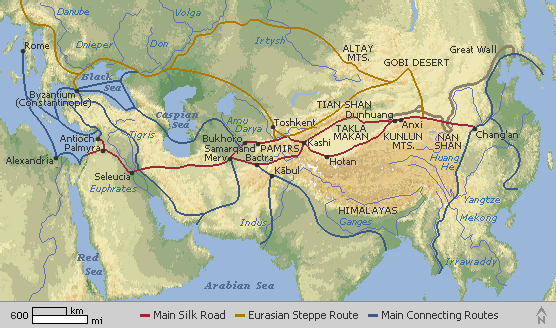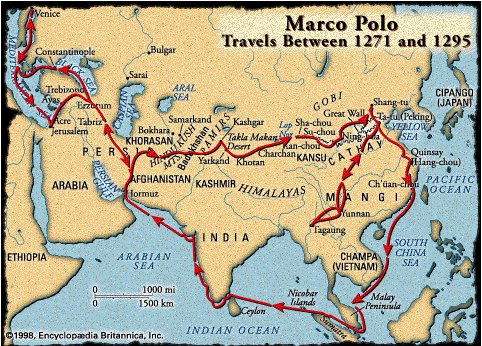I. Activating Prior Knowledge
“Originally, the Chinese trade silk internally, within the empire. Caravans from the empire's interior would carry silk to the western edges of the region. Often small Central Asian tribes would attack these caravans hoping to capture the traders' valuable commodities. As a result, the Han Dynasty extended its military defenses further into Central Asia from 135 to 90 BC in order to protect these caravans.
Chan Ch'ien, the first known Chinese traveler to make contact with the Central Asian tribes, later came up with the idea to expand the silk trade to include these lesser tribes and therefore forge alliances with these Central Asian nomads. Because of this idea, the Silk Road was born.
The route grew with the rise of the Roman Empire because the Chinese initially gave silk to the Roman-Asian governments as gifts.”
Source: http://library.thinkquest.org/13406/sr/
II. Setting a Purpose for Reading
As you read the maps and narrative, think about the following questions:
* What were the advantages/disadvantages of the Silk Road under the control of the Mongols?
* How did the Silk Road contribute to the Khans’ ability to conquer much of Asia?
* How did the Silk Road impact the cultures of Asia?
III. Reading the Text (Read, Re-Read, and Read Again!)
The partial unification of so many states under the Mongol Empire allowed a significant interaction between cultures of different regions. The route of the Silk Road became important as a path for communication between different parts of the Empire, and trading was continued.
Stop! Can you answer these questions? If not, go back and re-read the passage.
Why was the Silk Road significant to the people of Asia?
Although less `civilised' than people in the west, the Mongols were more open to ideas. Kubilai Khan, in particular, is reported to have been quite sympathetic to most religions, and a large number of people of different nationalities and creeds took part in the trade across Asia, and settled in China. The most popular religion in China at the time was Daoism, which at first the Mongols favoured. However, from the middle of the thirteenth century onwards, buddhist influence increased, and the early lamaist Buddhism from Tibet was particularly favoured. The two religions existed side by side for a long period during the Yuan dynasty. This religious liberalism was extended to all; Christianity first made headway in China in this period, with the first Roman Catholic arch-bishopric set up in Beijing in 1307. The Nestorian church was quite widespread in China; Jews and Moslems also populated several of the major cities, though they do not seem to have made many converts.
Stop! Can you answer these questions? If not, go back and re-read the passage.
How did the Silk Road contribute to religious diversity in Asia?
It was at this time that Europeans first ventured towards the lands of the `Seres'. The earliest were probably Fransiscan friars who are reported to have visited the Mongolian city of Karakorum. The first Europeans to arrive at Kubilai's court were Northern European traders, who arrived in 1261. However, the most well known and best documented visitor was the Italian Marco Polo. As a member of a merchant family from Venice, he was a good businessman and a keen observer. Starting in 1271, at the age of only seventeen, his travels with his father and uncle took him across Persia, and then along the southern branch of the Silk Road, via Khotan, finally ending at the court of Kubilai Khan at Khanbalik, the site of present-day Beijing, and the summer palace, better known as Xanadu. He travelled quite extensively in China, before returning to Italy by ship, via Sumatra and India to Hormuz and Constantinople.
Stop! Can you answer these questions? If not, go back and re-read the passage.
Why were Europeans traveling the Silk Road? Who was Marco Polo?
He describes the way of life in the cities and small kingdoms through which his party passed, with particular interest on the trade and marriage customs. His classification of other races centre mainly on their religion, and he looks at things with the eyes of one brought up under the auspices of the Catholic Church; it is therefore not surprising that he has a great mistrust of the Moslems, but he seems to have viewed the `Idolaters' (Buddhists and Hindus) with more tolerance. He judges towns and countryside in terms of productivity; he appears to have been quick to observe available sources of food and water along the way, and to size up the products and manufacture techniques of the places they passed through. His description of exotic plants and beasts are sufficiently accurate to be quite easily recognizable, and better than most of the textbooks of the period. He seems to have shown little interest in the history of the regions he was passing through, however, and his reports of military campaigns are full of inaccuracies, though this might be due to other additions or misinformation.
Stop! Can you answer these questions? If not, go back and re-read the passage.
Why were Marco Polo’s writings important?
Source: http://www.ess.uci.edu/~oliver/silk.html#6
IV. Personal Reflection – Respond to the following questions in your blog. Be sure to include quotes from the text to support your response.
Part 1 Response – Compare the two maps. What conclusions can you draw from your observations?
Part 2 Response – How might Marco Polo’s writings inspire European exploration and the voyages of such explorers as Christopher Columbus?
V. Peer Reflection – Read 3 classmates’ responses and respond to what they have written.
“Originally, the Chinese trade silk internally, within the empire. Caravans from the empire's interior would carry silk to the western edges of the region. Often small Central Asian tribes would attack these caravans hoping to capture the traders' valuable commodities. As a result, the Han Dynasty extended its military defenses further into Central Asia from 135 to 90 BC in order to protect these caravans.
Chan Ch'ien, the first known Chinese traveler to make contact with the Central Asian tribes, later came up with the idea to expand the silk trade to include these lesser tribes and therefore forge alliances with these Central Asian nomads. Because of this idea, the Silk Road was born.
The route grew with the rise of the Roman Empire because the Chinese initially gave silk to the Roman-Asian governments as gifts.”
Source: http://library.thinkquest.org/13406/sr/
II. Setting a Purpose for Reading
As you read the maps and narrative, think about the following questions:
* What were the advantages/disadvantages of the Silk Road under the control of the Mongols?
* How did the Silk Road contribute to the Khans’ ability to conquer much of Asia?
* How did the Silk Road impact the cultures of Asia?
III. Reading the Text (Read, Re-Read, and Read Again!)
The partial unification of so many states under the Mongol Empire allowed a significant interaction between cultures of different regions. The route of the Silk Road became important as a path for communication between different parts of the Empire, and trading was continued.
Stop! Can you answer these questions? If not, go back and re-read the passage.
Why was the Silk Road significant to the people of Asia?
Although less `civilised' than people in the west, the Mongols were more open to ideas. Kubilai Khan, in particular, is reported to have been quite sympathetic to most religions, and a large number of people of different nationalities and creeds took part in the trade across Asia, and settled in China. The most popular religion in China at the time was Daoism, which at first the Mongols favoured. However, from the middle of the thirteenth century onwards, buddhist influence increased, and the early lamaist Buddhism from Tibet was particularly favoured. The two religions existed side by side for a long period during the Yuan dynasty. This religious liberalism was extended to all; Christianity first made headway in China in this period, with the first Roman Catholic arch-bishopric set up in Beijing in 1307. The Nestorian church was quite widespread in China; Jews and Moslems also populated several of the major cities, though they do not seem to have made many converts.
Stop! Can you answer these questions? If not, go back and re-read the passage.
How did the Silk Road contribute to religious diversity in Asia?
It was at this time that Europeans first ventured towards the lands of the `Seres'. The earliest were probably Fransiscan friars who are reported to have visited the Mongolian city of Karakorum. The first Europeans to arrive at Kubilai's court were Northern European traders, who arrived in 1261. However, the most well known and best documented visitor was the Italian Marco Polo. As a member of a merchant family from Venice, he was a good businessman and a keen observer. Starting in 1271, at the age of only seventeen, his travels with his father and uncle took him across Persia, and then along the southern branch of the Silk Road, via Khotan, finally ending at the court of Kubilai Khan at Khanbalik, the site of present-day Beijing, and the summer palace, better known as Xanadu. He travelled quite extensively in China, before returning to Italy by ship, via Sumatra and India to Hormuz and Constantinople.
Stop! Can you answer these questions? If not, go back and re-read the passage.
Why were Europeans traveling the Silk Road? Who was Marco Polo?
He describes the way of life in the cities and small kingdoms through which his party passed, with particular interest on the trade and marriage customs. His classification of other races centre mainly on their religion, and he looks at things with the eyes of one brought up under the auspices of the Catholic Church; it is therefore not surprising that he has a great mistrust of the Moslems, but he seems to have viewed the `Idolaters' (Buddhists and Hindus) with more tolerance. He judges towns and countryside in terms of productivity; he appears to have been quick to observe available sources of food and water along the way, and to size up the products and manufacture techniques of the places they passed through. His description of exotic plants and beasts are sufficiently accurate to be quite easily recognizable, and better than most of the textbooks of the period. He seems to have shown little interest in the history of the regions he was passing through, however, and his reports of military campaigns are full of inaccuracies, though this might be due to other additions or misinformation.
Stop! Can you answer these questions? If not, go back and re-read the passage.
Why were Marco Polo’s writings important?
Source: http://www.ess.uci.edu/~oliver/silk.html#6
IV. Personal Reflection – Respond to the following questions in your blog. Be sure to include quotes from the text to support your response.
Part 1 Response – Compare the two maps. What conclusions can you draw from your observations?
Part 2 Response – How might Marco Polo’s writings inspire European exploration and the voyages of such explorers as Christopher Columbus?
V. Peer Reflection – Read 3 classmates’ responses and respond to what they have written.


 RSS Feed
RSS Feed